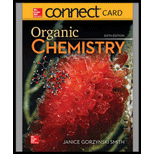
ORGANIC CHEMISTRY-ACCESS
6th Edition
ISBN: 9781260475586
Author: SMITH
Publisher: MCG
expand_more
expand_more
format_list_bulleted
Concept explainers
Textbook Question
Chapter 15, Problem 38P
Draw a stepwise mechanism for the following reaction.

Expert Solution & Answer
Want to see the full answer?
Check out a sample textbook solution
Students have asked these similar questions
Include stereochemistry Leven though the solutions manual does
14.43 Draw the products formed when each compound is treated with one not)
equivalent of HBr.
a.
b.
C.
14.41 Label each pair of compounds as stereoisomers, conformations, or
constitutional isomers: (a) A and B; (b) A and C; (c) A and D; (d) C and D.
A
B
C
D
Steps and detailed explanation for work. Thanks!
Chapter 15 Solutions
ORGANIC CHEMISTRY-ACCESS
Ch. 15.2 - Prob. 1PCh. 15.2 - Problem 17.2 What orbitals are used to form the...Ch. 15.3 - Prob. 4PCh. 15.3 - Problem-17.5 What is the structure of propofol,...Ch. 15.6 - Prob. 7PCh. 15.8 - Prob. 8PCh. 15.8 - Prob. 11PCh. 15.8 - Prob. 12PCh. 15.8 - Problem 17.16 Rank the following compounds in...Ch. 15.8 - Problem 17.17 Draw the seven resonance structures...
Ch. 15 - 17.23 Name each compound and state how many lines...Ch. 15 - Prob. 21PCh. 15 - Prob. 22PCh. 15 - 17.27 Give the IUPAC name for each compounds.
a....Ch. 15 - 17.28 Draw a structure corresponding to each...Ch. 15 - 17.29 a. Draw the 14 constitutional isomers of...Ch. 15 - Prob. 26PCh. 15 - Prob. 27PCh. 15 - 17.38
How many electrons does C contain?
How...Ch. 15 - Prob. 36PCh. 15 - 17.40 Explain the observed rate of reactivity of...Ch. 15 - 17.41 Draw a stepwise mechanism for the following...Ch. 15 - Prob. 39PCh. 15 - 17.43 Draw additional resonance structures for...Ch. 15 - Prob. 41PCh. 15 - Prob. 42PCh. 15 - 17.46 Which compound in each pair is the stronger...Ch. 15 - 17.47 Treatment of indene with forms its...Ch. 15 - Prob. 45PCh. 15 - 17.49 Draw the conjugate bases of pyrrole and...Ch. 15 - 17.50 a. Explain why protonation of pyrrole occurs...Ch. 15 - Prob. 48PCh. 15 - Prob. 49PCh. 15 - 17.53 How many signals does each compound...Ch. 15 - 17.54 Which of the diethylbenzene isomers (ortho,...Ch. 15 - 17.55 Propose a structure consistent with each...Ch. 15 - 17.56 Propose a structure consistent with each...Ch. 15 - 17.57 Thymol (molecular formula ) is the major...Ch. 15 - 17.58 You have a sample of a compound of molecular...Ch. 15 - 17.59 Explain why tetrahydrofuran has a higher...Ch. 15 - 17.60 Rizatriptan (trade name Maxalt) is a...Ch. 15 - 17.61 Zolpidem (trade name Ambien) promotes the...Ch. 15 - 17.62 Answer the following questions about...Ch. 15 - 17.63 Stanozolol is an anabolic steroid that...Ch. 15 - Prob. 61P
Knowledge Booster
Learn more about
Need a deep-dive on the concept behind this application? Look no further. Learn more about this topic, chemistry and related others by exploring similar questions and additional content below.Similar questions
- 14.39 Draw the structure of each compound. a. (Z)-penta-1,3-diene in the s-trans conformation b. (2E,4Z)-1-bromo-3-methylhexa-2,4-diene c. (2E,4E,6E)-octa-2,4,6-triene d. (2E,4E)-3-methylhexa-2,4-diene in the s-cis conformationarrow_forwardPLEASE ANSWER ALL PARTS!!arrow_forwardpls help on all, inlcude all steps.arrow_forward
- 19. Complete the following chart for the incorrect electron configurations shown in the left column. When drawing the correct electron configuration, assume the same number of electrons that were shown in the incorrect configuration. Incorrect Electron Configuration 2p ↑↓ ↑ 2s ↑↓ 1s ↑↓↓ ਵੇ ਵੇ ਵੇ 3p ↑ ↑ ↑ - 38 ↑ 2p 2s ↑↓ 1s 2p 2s 1s ** ↑↓ ↑↓ ↑↑ 리리리 Which principle or rule is violated? Explain the violated principle or rule in your own words Draw the correct electron configurationarrow_forward14.36 Draw all reasonable resonance structures for each compound. a. + b. C. :O: d. :O: NH2 NH2 :O:arrow_forward14.32 What diene and dienophile are needed to prepare each compound by a Diels-Alder reaction? a. b.arrow_forward
- 14.34 Draw all reasonable resonance structures for each species. a. b. Ö :0: C. :0: :0: d. OH e. f. :O:arrow_forward7. The standard reduction potentials for two half-reactions are shown above. Which of the statements listed below will be true for the following reaction taking place under standard conditions? a. E° b. E° c. E° = d. E° e. E° = Al (s) + Cr³+ → Al³+ + Cr (s) 0.93 V, and the reaction is not spontaneous 0.93 V, and the reaction is spontaneous 2.39 V, and the reaction is not spontaneous 2.39 V, and the reaction is not spontaneous 0.93 V, and the reaction is spontaneous Cu2+ + 2e → Cu E° = +0.34 V Zn2+ + 2e → Zn E° = -0.76 V E° = -1.18 V Mn2+ + 2e → Mn 8. Based on the above reduction potential, which of the following reactions will occur spontaneously? a. Mn²+ + Cu → Mn + Cu2+ b. Mn²+ + Zn → Mn + Zn²+ c. Zn2+ + Cu → Zn + Cu²+ d. Zn²+ + Mn → Zn + Mn2+ e. Cu²+ + Zn²+ → Cu + Znarrow_forward14.35 For which compounds can a second resonance structure be drawn? Draw an additional resonance structure and the hybrid for each resonance-stabilized compound. a. OCH3 OCH 3 b. C. d. CH3 NHCH3arrow_forward
arrow_back_ios
SEE MORE QUESTIONS
arrow_forward_ios
Recommended textbooks for you
 Organic Chemistry: A Guided InquiryChemistryISBN:9780618974122Author:Andrei StraumanisPublisher:Cengage Learning
Organic Chemistry: A Guided InquiryChemistryISBN:9780618974122Author:Andrei StraumanisPublisher:Cengage Learning

Organic Chemistry: A Guided Inquiry
Chemistry
ISBN:9780618974122
Author:Andrei Straumanis
Publisher:Cengage Learning
Nomenclature: Crash Course Chemistry #44; Author: CrashCourse;https://www.youtube.com/watch?v=U7wavimfNFE;License: Standard YouTube License, CC-BY